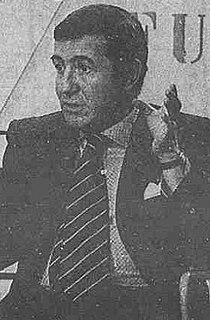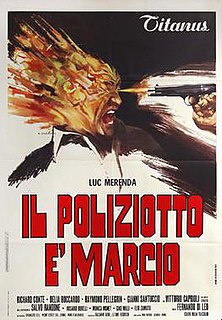Antonio Margheriti, also known under the pseudonyms Anthony M. Dawson and Antony Daisies, was an Italian filmmaker. Margheriti worked in many different genres in the Italian film industry, and was known for his sometimes derivative but often stylish and entertaining science fiction, sword and sandal, horror/giallo, Eurospy, Spaghetti Western, Vietnam War and action movies that were released to a wide international audience. He died in 2002.

Umberto Lenzi was an Italian film director, screenwriter, and novelist.

Kriminal is an Italian comics series featuring an eponymous fictional character, created in 1964 by Magnus and Max Bunker, the authors of Alan Ford, Maxmagnus and Satanik.

Fernando Di Leo was an Italian film director and script writer. He made 17 films as a director and about 50 scripts from 1964 to 1985.

Andrea Bosic was an Italian film actor of Slovene origin. He appeared in more than 50 films between 1951 and 1985, mainly in films called Spaghetti Westerns. His co-acted with actors as John Phillip Law, Giuliano Gemma, Lee Van Cleef and Ivan Rassimov. He was born as Ignazio Andrej Božič in Gomilško, now a suburb of Maribor, Slovenia.
Stelvio Massi, sometimes credited "Max Steel", was an Italian director known for his "poliziotteschi" films.
Fernando Cerchio was an Italian film director and screenwriter. He directed more than 30 films between 1940 and 1972.
Marino Girolami was an Italian film director and actor.

Duccio Tessari was an Italian director, screenwriter and actor, considered one of the fathers of Spaghetti Westerns.

Kidnap Syndicate is a 1975 Italian poliziottesco film directed by Fernando Di Leo. Even being a minor work in the Di Leo's filmography, the film gained some critical attention for being an original re-interpretation of the "vigilante" subgenre.

The Bloodsucker Leads the Dance is a 1975 Italian film directed by Alfredo Rizzo.

Shoot First, Die Later is a 1974 Italian poliziottesco-noir film directed by Fernando Di Leo. Di Leo reprises some elements of the novel Rogue Cop by William P. McGivern. Luc Merenda later starred in two other Di Leo's films, Kidnap Syndicate and Nick the Sting.

Kriminal is a 1966 superhero film directed and written by Umberto Lenzi. The film is about a thief and murderer called Kriminal who escapes from a prison and is chased after by Inspector Milton. It was followed by a sequel, Il marchio di Kriminal.

Stateline Motel is a 1973 Italian crime film directed by Maurizio Lucidi.

The Cursed Medallion is a 1975 Italian horror film directed by Massimo Dallamano, and starring Richard Johnson, Joanna Cassidy, and Ida Galli.

City Under Siege is a 1974 Italian poliziottesco film directed by Romolo Guerrieri. The film is loosely based on Il commissario di Torino by Riccardo Marcato and Ugo Novelli.
Luigi Carpentieri (1920-1987) was an Italian assistant director (1940-1949) and film producer (1947-1968). Together with Ermanno Donati, he founded the production company "Athena Cinematografica", which in 1960 became "Panda Cinematografica". All films produced by [[the company were genre films.

Roel Bos, better known by his stage name Glenn Saxson, is a Dutch actor and film producer. Bos moved to Italy in 1964 and starred in several Western films as well as the lead in the superhero film Kriminal and its sequel Il marchio di Kriminal. Following these roles he continued acting in Italian and German productions until the late 1960s. He began work in the 1970s as a producer as he had "more artistic ideas in mind", and worked with director Sergio Nasca, producing his films The Profiteer and Vergine e di nome Maria.













